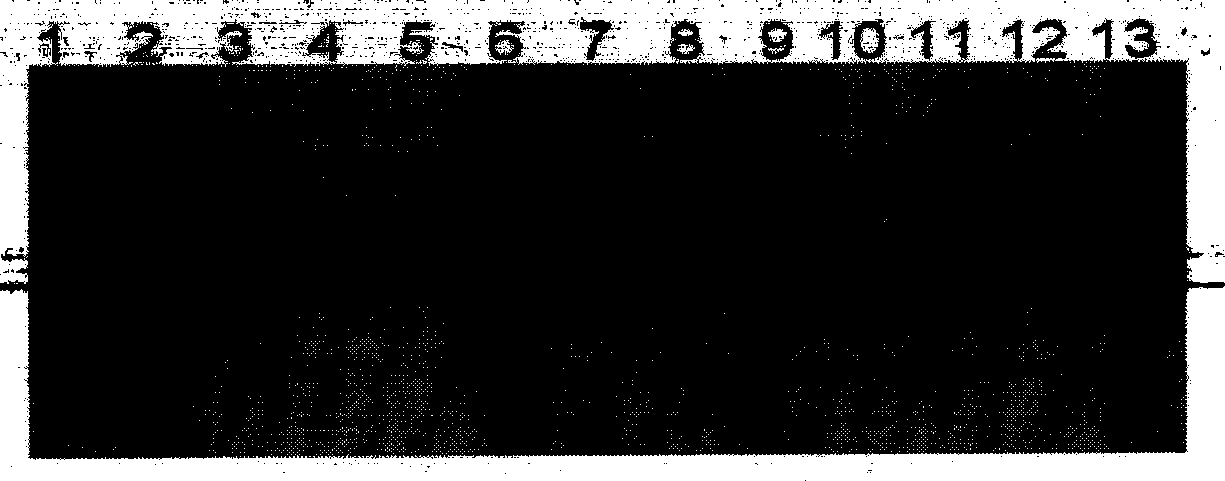Specific probes for identification of asparagus 981 fine variety and its application
A specific and asparagus technology, applied in the field of specific probes for identifying asparagus 981 varieties, can solve the problems of cumbersome operation and long test period
- Summary
- Abstract
- Description
- Claims
- Application Information
AI Technical Summary
Problems solved by technology
Method used
Image
Examples
Embodiment 1
[0040] The specific probe for identifying the improved variety of Asparagus 981 provided by the present invention has the nucleotide sequence described in SEQ ID NO:1 or SEQ ID NO:2.
Embodiment 2
[0042] Asparagus Genomic DNA Extraction
[0043] Extract by CTAB method, weigh 2.5g fresh asparagus, add 5ml CTAB buffer solution and 2g PVPP solid, add liquid nitrogen to grind into powder, and quickly transfer to 10ml plastic centrifuge tube. Incubate at 65°C, shake gently every 5min for several times, centrifuge at 12000r / min for 15min after 30min, carefully absorb the supernatant, add proteinase K to a final concentration of 100μg / ml, 50°C, 3h, mix by inverting from time to time. Extract with equal volume of phenol / chloroform for 10min, centrifuge at 12000rpm for 5min, carefully absorb the supernatant, extract with chloroform for 5min, centrifuge at 12000rpm for 5min, take the supernatant, add 2 / 3 volume of isopropanol, mix it upside down, and store it at -20 Precipitate at ℃ for 15 min, centrifuge at room temperature 12000 rpm for 15 min, remove the supernatant, wash the precipitate with 1 ml of 70% ethanol, centrifuge at 12000 rpm for 15 min, remove the supernatant, and ...
Embodiment 3
[0117] Probes were designed using the two specific fragments obtained in Example 2, and the probe sequences were: SEQ ID NO: 1 and SEQ ID NO: 2. Label the probe and detect the labeling rate according to the instructions of the digoxin labeling kit, prepare the labeled probe and the control according to the operation instructions of the kit, spot each 1 μl of tubes 2-9 on the membrane, let the membrane dry naturally, and bake at 80°C for 2 hours. Add 5ml of buffer I to the membrane in a small beaker [i.e. washing buffer: 0.1M maleic acid, 0.15M NaCl; pH7.5 (20°C); 0.3% (v / v) Tween-20], wash for 5min, pour off Buffer I, add 10ml buffer II [blocking solution, use maleic acid buffer (0.1M maleic acid, 0.15M NaCl, pH7.5) to mix 10×Blocking Solution (tube 6) in a ratio of 1:10 Dilute to 1×working solution], place at room temperature for 30min, pour off buffer II, put the membrane in a petri dish, add 10ml of buffer II to the petri dish, keep at room temperature for 30min, take out t...
PUM
 Login to View More
Login to View More Abstract
Description
Claims
Application Information
 Login to View More
Login to View More - R&D
- Intellectual Property
- Life Sciences
- Materials
- Tech Scout
- Unparalleled Data Quality
- Higher Quality Content
- 60% Fewer Hallucinations
Browse by: Latest US Patents, China's latest patents, Technical Efficacy Thesaurus, Application Domain, Technology Topic, Popular Technical Reports.
© 2025 PatSnap. All rights reserved.Legal|Privacy policy|Modern Slavery Act Transparency Statement|Sitemap|About US| Contact US: help@patsnap.com



